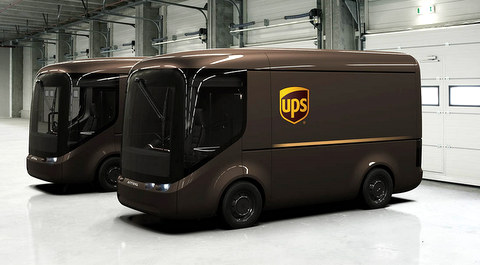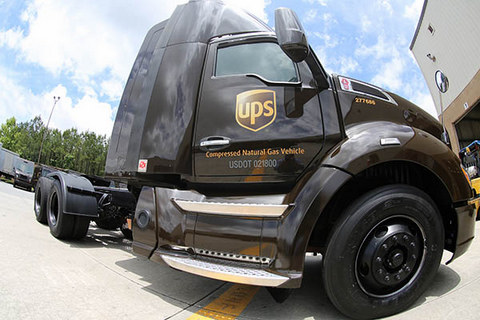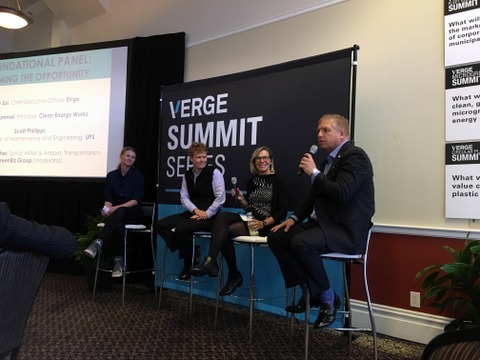Scott Phillippi’s ‘Rolling Laboratory’ Leaves Behind Fossil Fuels
UPS manages a fleet that includes more than 1,000 electric and hybrid electric vehicles, as part of its “Rolling Laboratory” of approximately 9,300 alternative fuel and advanced technology vehicles. Moving from diesel to electricity is one way the company is working toward its goals of reducing greenhouse gas emissions. But the shift to electric-power brings with it the need to address an increase in charging capacity. To be an effective strategy, UPS, along with other commercial fleet operators, is evaluating whether the savings on fuel and maintenance offsets the initial higher cost of buying electric trucks today.

To look into the many factors involved in moving to electric fleet vehicles, UPS partnered with GreenBiz and recently published a white paper called “Curve Ahead: The Future of Fleet Electrification.” It highlights the top motivators for and barriers to fleet electrification and discusses strategies for overcoming those barriers and accelerating the electrification process.
Per the white paper, the primary motivator for electrifying fleets is to achieve sustainability goals, as reported by 83 percent of research responders. Other reasons include a lower cost of ownership, financial incentives and the need to respond to policy changes. However, the top barriers today are limited product availability, high purchase price and the lack of charging infrastructure in survey responders’ facilities.
Opportunities & Challenges Ahead
At the recent VERGE Conference and Expo in Oakland, California, I spoke with Scott Phillippi, UPS’s senior director of maintenance and engineering–International Operations. Phillippi oversees fleets globally for UPS, and is a member of the Society of Automotive Engineers (SAE) and a board member of Calstart and Clean Cities.
Phillippi sees both opportunities and challenges ahead. While electrification is desirable, there are also some impediments—and it won’t work for every application.

“Electric vehicles are cool and are a hot topic, but they are not yet ideal for long-distance hauls,” he says. “But it could be applicable for a 300-mile semi.”
As part of its ongoing research, UPS has ordered 125 Tesla semi tractors. When they are delivered, the company will integrate them into its “rolling laboratory” of vehicles and assess the results. UPS is also planning to test some of Thor’s electric medium-duty delivery trucks.
UPS has successfully run the Smart Grids project in London, which worked on solutions to mass-charging of a large EV fleet.
“With careful management, we were able to create efficiencies to allow charging of 170 vehicles instead of the 65 we originally planned for,” said Phillippi.
Sometimes Only Small Changes Are Needed
One of UPS’s findings from continued testing is that some trucks only need partial charges to complete a route.
Managing charging for electric fleets is a big hurdle to future adoption, which UPS is working to solve.
“With our wide range of vehicle applications, we haven’t found the one perfect solution yet,” Phillippi said. “However, we have more than 300 electric vehicles in the fleet right now—most of these are retrofitted from diesel vehicles—the experience gained has helped UPS determine what works best.”

It’s a matter of building the right business case—combining sustainability with good business choices.
“We are actively seeking solutions, but there is a lack of choices, and not enough data yet,” said Phillippi. “It’s not an emotional decision, but a mathematical, business one.”
UPS has committed that by 2020, 25 percent of its vehicles purchased annually will be alternative fuel or advanced technology vehicles. They currently are running more than 5,200 NG (natural gas) vehicles, accounting for eight million miles a week. Per Phillippi, they are using RNG (renewable natural gas) where possible.
Phillippi understands electric vehicles, as a former Nissan Leaf owner who now drives a Tesla Model 3 (Performance model). With his personal leadership, combined with the technical advances and greater range of options in the future, UPS should be able to upgrade its fleet to make an impact on sustainability.
“A global solution is on the horizon,” said Phillippi. “We will take a collaborative approach, getting input from the business and other stakeholders—everyone’s point of view.”
More UPS Insights from a VERGE Panel
Tamara Barker, UPS’s Chief Sustainability Officer and VP of Environmental Affairs, spoke at a VERGE panel called “Why Early Adopters are Electrifying Commercial Fleets.”
“The issues for UPS’s fleet are the same as they are for car customers–charging infrastructure and range,” she said.

Barker says UPS will have to work with the electricity utilities, too.
“Running new wiring to power an EV (electric vehicle) fleet means collaborating with utilities to lower costs,” Barker said. “We need a Smart Grid and one centralized system based on vehicle need.”
Some of UPS’s routes are not yet suited for an EV’s limited range. UPS operates in more than 220 countries and territories, and Barker and Phillippi agree—there’s no single solution that will work for all cases.
Barker believes UPS should work on bringing in medium-duty vehicles first.
“We’re looking for the right situations–high density, fewer miles and appropriate routes,” she said.
Between thoughtful leadership, serious research and testing, UPS is on the way to evolving its fleet.
Related Stories You Might Enjoy—More Verge & UPS News
Verge 2018: General Motors amps Up Renewable Energy
Verge 2018: A Business Approach to Sustainable Transport
News: UPS Tests Cargo eBikes in Seattle
News: UPS To Test Thor Electric Delivery Trucks
News: UPS Delivers with Hydraulic Hybrid Vehicles
News: UPS Fleet Includes Hybrid & CNG Delivery Trucks

13 thoughts on “Interview: UPS Looks Toward an Electric Fleet”